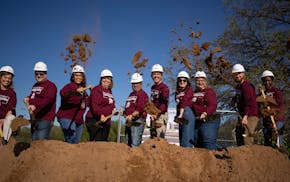Adrean Clark is an American Sign Language (ASL) Deaf writer and artist who is committed to creating more opportunities for deaf people to better express themselves in written ASL. To further her work, Clark was named a 2024 Bush Foundation fellow and plans to use the fellowship over the next two years to earn a Ph.D. from Concordia University in Montreal.
But when it came time to interview Clark, Eye On St. Paul dropped the ball.
By the time I emailed a list of questions to her a little more than a week ago, she was in the final throes of packing for Montreal and had little time to respond. I should have known better than to wait.
Being crazy-busy is par for her course.
How busy? Seeing a need, with her partner, John Lee Clark, she co-founded a publishing company. There, they've showcased the work of ASL speakers. She has also established an online dictionary for written ASL that eventually became the ASLwrite method. Her works include magazine articles she's authored, comics she's created, and art prints she has drawn and painted.
In one blurb about her, Clark said she believes in the ability to transform spoken ASL to two-dimensional spaces through visual art.
And now, as Clark told the folks at the Bush Foundation, she plans to expand her research on how ASL is represented on paper.
Clark said she hopes her visual language approach will influence educators to infuse culturally appropriate visual materials into their curriculum, allowing the ASL Deaf community to feel confident in expressing themselves in written ASL and other sign language-centric mediums.
So, she answered a couple questions and directed Eye On St. Paul to some of the material she's created to explain her work. This story attempts to bring together those elements. It has been edited for length and clarity.
Q: Tell me about you. Where did you grow up? Do you have brothers? Sisters?
A: I was born Deaf into a hearing family. I have one younger sister.
Q: Tell me about your education. Where did you go to school — elementary, high school, college? Postgraduate?
A: [I was] mainstreamed in public school until the 8th grade when I transferred to the Central North Carolina School for the Deaf. I learned ASL at CNCSD. I eventually graduated from the North Carolina School for the Deaf. Attended Gallaudet University. Years later I earned my [Master's in Fine Arts] in Visual Art from Vermont College of Fine Arts.
Q: Tell me about written American Sign Language; how does it differ from standard written English?
A: Written ASL works like English in that it represents elements of the spoken language on paper. The difference is that ASL is a visual language, while English is an aural language. The marks of written ASL evoke the visual elements of ASL. English has letters representing sounds, while written ASL has marks representing the hands, the body, and the movements. Visual examples are at facebook.com/groups/ASLwrite/media.
Q: In your Bush Foundation biography, it said that you hope to create opportunities for Deaf communities to heal from the trauma of linguicism. I haven't heard that term before. What is it?
A: Linguicism in terms of the ASL community is pervasive discrimination against ASL and other sign languages in favor of English. A general description of linguicism is at thoughtco.com/what-is-linguicism-1691238.
Q: Please tell me a little about your work.
A: [Clark sent me a Dropbox link containing examples of zines she has created including entries titled "The Way Above" and "ASL For a Better Life." What follows are a couple questions she received from the folks at Bush and her answers.]
Q: What has informed your approach to leading change in your community?
A: Leadership is a collaborative process; one needs to connect with others in a mutual exchange that brings change. In aural-centric languages like spoken English, one imagines the sound to reach other ears nearby, whether or not we see them. American Sign Language (ASL) is different. We depend on the visual feedback of others to continue our conversations. It is natural for us to take turns contributing to the collective discourse. We are present.
Q: What is the thing you have done that you are most proud of?
A: The process of learning about my own neurodiversity helped me learn about the different layers of communication. It's not language alone that connects us with other people — it's a rich cornucopia of meaningful perspectives that deepen our consciousness as people. I deeply appreciate experiencing this learning process.
To learn more about Adrean Clark and to see some of her work, go to adreanclark.com and adreanaline.com.
Enjoy.

Pope Leo XIV calls for peace in Ukraine and Gaza in symbolically rich blessing on Mother's Day

Orono voters head to polls Tuesday for special City Council election
New program at U of M facilitates veterans' path from combat medics to doctors

As many Minnesota schools shrink, this part of the metro is seeing an enrollment boom

